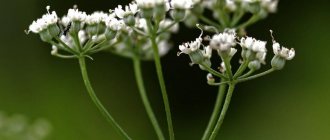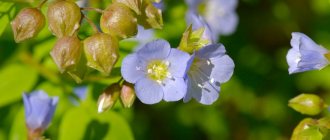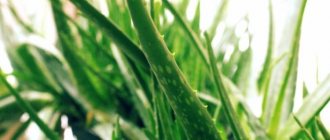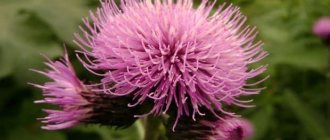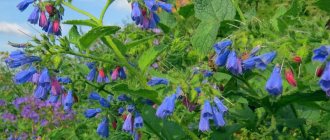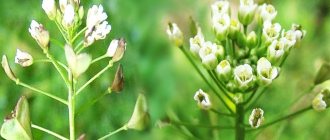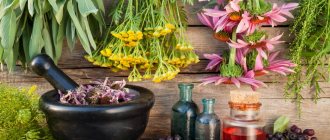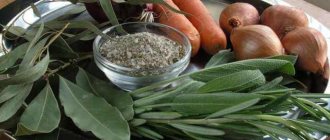Coltsfoot is a plant widespread throughout the CIS and belongs to the Compositae family.
Coltsfoot is recognized as official in medicine, but traditional medicine uses it much more widely. In addition to traditional use for colds, it has proven itself well for women's diseases. The plant is a honey plant: coltsfoot blooms when there are no other sources for nectar and pollen.
Botanical description of coltsfoot
The medicinal plant coltsfoot is a herbaceous perennial. Height 10-25 cm. The rhizome is long, thick, creeping, branched with thin roots, covered with scales at the apex.
Flowering stems, single or several, appear before the leaves. Straight, with oblong leaves, covered with small hairs, have scales. The color of the leaves is brownish-red.
The main leaves appear after the plant has flowered. They are located at the roots on long petioles, rounded-heart-shaped, have veins, and are covered with uneven teeth along the edges. When describing the coltsfoot plant, you should note that the upper side of the leaves is light green, smooth, hard and cold, and the lower side is white-felt, soft and warm. Width – 10-25 cm.
Coltsfoot flowers are located on the tops of the stems in several rows, the middle ones are tubular, the edges are reed-shaped, surrounded by a two-row wrapper of uniform linear pubescent leaves. Diameter – 2-2.5 cm, color – yellow and golden yellow. In the evening, as well as in damp weather, the inflorescences close.
The fruit is an oblong achene with a hairy tuft, characterized by increased germination. Length – 3.5-4 mm.
Blooms in March-May. The fruits ripen in May-June. Propagated by seeds and vegetatively.
Growing technology
In most regions, raw materials are harvested in natural conditions, but if necessary, you can cultivate the plant on your own site. In particular, beekeepers are willing to breed honey plants, because the one-sided plant produces tasty honey - primrose allows you to increase the volume of the first collection.
The shrub is not fussy to care for, so abandoned wastelands are chosen for its cultivation.
It can be propagated by both vegetative and seed methods. Most often the rhizome is divided. Thanks to its good adaptation and neutral effect on the soil, the plant can grow for years without replanting.
Since the king potion multiplies quickly, it is necessary to control the area it occupies. Grass grows best on the sunny side and responds well to organic fertilizers. It is better to apply them in the fall. Water areas in extreme heat, trying to protect the upper side of the leaf from moisture. Double leaf does not need weeding.
In landscape design, it is used for flower beds, rockeries, and rock gardens, because the grass is even superior to bindweed in terms of drought resistance.
With the vegetative method of propagation in the spring, the daughter root is separated and replanted. By the end of summer, a solid colony has formed.
Because of its self-seeding, mini copies of the plant can be seen throughout the garden over time. Over the course of three years, they adapt, form a root system, and then begin to actively bloom.
Collection and preparation
For medicinal purposes, mainly the leaves of the plant are used, less often the flowers and roots.
Coltsfoot (leaves) are collected in June-July, 2-3 weeks after the seeds form; they should not be young. Dry in the shade, with good air ventilation, spreading out in a thin layer, remembering to toss frequently. Shelf life – 3 years.
Flowers are collected at the beginning of flowering, before they open, by removing the stems. Dry as usual, spreading out in a thin layer. Shelf life – 2 years.
The roots are harvested in spring and autumn. Shelf life – up to three years.
Raw materials are stored in canvas, paper bags, boxes, boxes in a well-ventilated area.
Reproduction
The mother lily can infect crops and is often a pioneer in infecting dry areas, especially those with sandy soil.
This good spread is due to the active spread of the plant. Upland queen plant can be equally well propagated vegetatively and by seeds. Each part of the rhizome, being broken off, grows back and produces a new individual.
Propagation by seeds is also effective, since each plant produces more than five thousand seeds. Scattered by the wind, they germinate in moist soil within the first 24 hours.
Chemical composition
The medicinal properties of leaves (herbs) of coltsfoot are due to the content of the following substances in their composition: glycoside tussilarin, inulin, sitosterol, gallic, malic, tartaric and ascorbic acids, saponins, tannins and mucous substances, essential oil.
In addition, they contain the following macro- and microelements: potassium (37.70 mg/g), calcium (10.90 mg/g), iron (0.20 mg/g), bromine (107.10 μg/g ), boron (40.0 µg/g), selenium (25.00 µg/g), nickel (21.00 µg/g), silver (8.00 µg/g), copper (0.78 µg/g ), zinc (0.60 µg/g), molybdenum (0.40 µg/g), polonium (0.24 µg/g), cobalt (0.27 µg/g), etc.
Coltsfoot flowers contain: triterpenes (faradiol and arnidiol), tetraterpene taraxanthin, stigmasterol and sitosterol, carbohydrate heptacosane, tannins. Routine is also an important element.
Coltsfoot. Therapeutic effects on the body
A large number of people, freely using plants to treat various diseases, believe that they are absolutely harmless. However, among medicinal plants there are also toxic and even poisonous. In addition, most people have chronic diseases.
Therefore, in order for the treatment to be effective and beneficial, the medicinal and beneficial properties of coltsfoot and contraindications should be taken into account, and only a doctor can do this. Based on this, before you start treatment with the medicinal plant coltsfoot, consult a doctor, or better yet, a herbalist you trust. The information given below is for informational purposes only.
Cardiovascular diseases
The plant is recommended for the treatment of atherosclerosis and strengthening of blood vessels. In addition to the leaves, coltsfoot flowers have been used for hypertension.
Coltsfoot is used for heart diseases and also helps relieve pain.
Having antispasmodic properties, the leaves are used to relieve headaches. To do this, they are applied fresh to the back of the head, temples, and on the forehead with the upper, green side.
Gastrointestinal diseases
Coltsfoot has found use for the treatment of gastrointestinal diseases. Plant preparations help improve digestion and increase appetite. They are used for inflammatory diseases of the gastrointestinal tract (gastritis, etc.), stomach and duodenal ulcers, gastric catarrh, as an astringent, and for diarrhea. For inflammatory bowel diseases, enemas are done.
Colds and bronchopulmonary diseases
Coltsfoot preparations (decoction, infusion, juice, powder) are a widely known remedy, both in official and folk medicine, for the treatment of various colds and bronchopulmonary diseases. For these purposes, the plant is used both internally and as a rinse.
Coltsfoot has an enveloping, diaphoretic, expectorant and antitussive effect and is recommended for diseases such as colds, flu, inflammation of the upper respiratory tract, laryngitis, tracheitis, hoarseness, suffocation, shortness of breath, bronchitis, bronchial asthma.
To enhance the effect, drink the infusion with honey or raspberry jam. Another effective recipe is an infusion of the leaves in hot milk with the addition of honey.
Shortness of breath, suffocation, runny nose
For shortness of breath, suffocation, as well as cough, coltsfoot is taken in the form of juice with honey (3-5 tablespoons per dose).
Sinusitis, runny nose
The plant is used as instillation (juice), rinsing (warm infusion), inserting a tampon soaked in juice or infusion into the nose, putting in herbal gruel from fresh leaves, breathing in the smoke of leaves smoldering on the stove, sniffing powder from the dry roots of coltsfoot .
Lung diseases
Coltsfoot is very effective for lung diseases, such as pleurisy, pneumonia, tuberculosis, abscess, and gangrene of the lungs.
For tuberculosis, in addition to the infusion of the plant, juice from the leaves with sugar is taken as an expectorant.
For women
The healing and beneficial properties of coltsfoot have proven themselves well for women's health. The infusion is douched for various inflammations. For fibroids, douching is done with juice.
Coltsfoot also helps with breast diseases. Fresh leaves or pulp from them are used in the form of compresses for mastitis and mastopathy. Steamed dried leaves can be used for the same purpose, but the effect in this case will be lower. The leaves can also be soaked in hot cream.
urinary system
Since coltsfoot has a diuretic effect, traditional medicine recommends it for dropsy and edema. In addition, the plant is used to treat kidney diseases (nephritis, etc.) and bladder diseases (cystitis, etc.).
For the nervous system
Coltsfoot has also been used to restore the nervous system. For this purpose, various plant preparations are taken orally (infusion of leaves, flowers, juice, powder). This also helps with epilepsy.
For hair
A good result is obtained by rinsing the hair with an infusion of coltsfoot to treat dry seborrhea, dandruff, itchy scalp, and weakened hair.
Oral diseases
The beneficial and medicinal properties of coltsfoot are used as rinses for inflammatory processes in the oral cavity, such as stomatitis, ulcers, etc. Well-brushed leaves are placed on sore teeth. Smoking dry coltsfoot leaves also helps relieve toothache.
Wounds, burns, tumors, ulcers...
The healing properties of coltsfoot are widely used to treat various damage to the skin, such as: wounds (including deep purulent ones that threaten gangrene), ulcers (including trophic ones), abscesses, boils, frostbite, inflammation of the veins in the legs ( thrombophlebitis), burns, tumors, etc. For these purposes, baths, washes, compresses, lotions are made.
Fresh leaves with the lower white side are applied to tumors and abscesses: this helps draw out the pus. In cold weather, steamed leaves are used.
A paste of fresh leaves is applied to the inflamed veins.
Coltsfoot helps get rid of calluses. To do this, tampons soaked in plant juice are placed on them overnight.
Skin diseases
The medicinal and beneficial properties of coltsfoot have proven themselves well for skin diseases, such as itching, allergies, scrofula, erysipelas, diathesis in children, etc. For these purposes, infusion and juice of the plant are used in the form of baths, washes, compresses, lotions, etc.
A paste of fresh coltsfoot leaves is applied to the skin for erysipelas.
For the whole body
Coltsfoot is a good remedy for strengthening the body; it gives a noticeable effect against general weakness and vitamin deficiency. To do this, the young leaves of the plant are used in salads in the spring, and the juice is also drunk.
What does it help with?
The medicinal plant will help heal and alleviate the condition of:
- Colds, infectious and viral diseases;
- Pulmonary and bronchial diseases;
- Inflammation of the mucous membrane;
- Gastrointestinal problems (stomach ulcer, gastritis, enterocolitis);
- Kidney diseases;
- Bladder catarrh;
- Pulmonary tuberculosis (in the initial stage);
- Diseases of the upper respiratory tract (sore throat, cough, rhinitis);
- Scrofula;
- Headache;
- Atherosclerosis;
- Painful and irregular periods;
- Diseases of the upper respiratory tract (sore throat, cough, rhinitis);
- Hypertension;
- Increased cholesterol levels;
- Weakened immunity.
The mucus contained in the plant envelops the mucous membrane of the upper respiratory tract and relieves irritation. Saponins and organic acids dilute mucus and phlegm and remove them from the body. Essential oils tone the body. Glycosides normalize heart function. Tannins kill pathogenic microflora during colds and viral infections.
Dosage forms
Leaf infusion
1 tbsp. pour 200 ml of leaves. boiling water Cover the dish with a lid, insulate it and let it brew for 45 minutes. Strain. Store in a cool place for no more than two days.
Take 1/4-1/3 tbsp. 2-3 times a day an hour before meals.
Juice
To prepare the juice, the leaves are collected in May-June. They are washed well under running water, scalded with boiling water, passed through a meat grinder, and then the juice is squeezed out using gauze.
The finished juice is diluted with water in a ratio of 1:1 and boiled for 2-3 minutes.
Take 1 tbsp. 3 times a day after meals. The course of treatment is 7-10 days.
Coltsfoot. Traditional medicine recipes
Cold
Dried leaves are ground into powder and mixed with honey in a 1:1 ratio.
Take 1 tsp. 3 times a day, washed down with warm water or herbal decoction.
Sore throat, laryngitis
Mix freshly squeezed juice from coltsfoot leaves (how to prepare, see above) in equal quantities (1:1:1) with onion juice and natural red wine. Store in a cool place. Shake before use
Take 1 tbsp 3 times a day, stirring well in 3 tbsp. boiled water.
Helps well with chronic colds. It is stronger than antibiotics.
Tuberculosis
Fresh coltsfoot leaves and sugar are placed in a glass jar in layers. The width of the layer is about 2 cm. The jar is filled to the top, closed tightly with a lid and left in a cool, dark place for 3 weeks. According to the folk recipe, the container should be buried in the ground to a depth of half a meter.
During this time, a homogeneous green mass is formed, which should be mixed well. Then it is combined with natural honey in a ratio of 1 kg. mass per 500 g. honey Mix everything well again. The medicine is stored in a cool place.
Take 1 tbsp. 3 times a day half an hour before meals.
For the healing of tuberculous pulmonary ulcers (cavities).
To strengthen hair and prevent dandruff
3-6 tbsp. fresh or dried coltsfoot leaves and the same number of nettle leaves, pour a liter of boiling water. Cover the dish with a lid, insulate it and leave for an hour. Strain.
Rinse your hair with a weaker infusion after washing. The roots of clean hair are impregnated with a more concentrated solution at least 1-2 times a week.
Using Tsar Potion in everyday life
Flowers and leaves are placed in salads, tea, soups, and honey. To get rid of bitterness, the prepared herb is scalded with boiling water. Dry powder is added to baked goods.
Kamchuzh grass salad with carrots
For 30 g of leaves you need 50 g of carrots and 30 ml of kefir. Wash the ingredients, chop, season with kefir, add salt.
Rannik salad with cabbage
Prepare 100 g of rannik leaves. Add sauerkraut (300 g), season with vegetable oil (40 ml).
Two-faced soup
Boil 200 g of potatoes, add 100 g of crushed Tsar Potion leaves, add salt, and leave for a few minutes. Serve with sour cream.
Herbal lozenges
To prepare your favorite English delicacy for 15 cups of raw materials, you will need 5 cups of water, 450 g of sugar, 2 cups of corn syrup, 3 tablespoons of butter and a spoonful of vegetable oil, and a pinch of soda.
Boil the washed leaves in a saucepan. Add the remaining ingredients (except baking soda) and cook until the drop stops spreading in the water. Now you can add baking soda and beat with a blender until it becomes more dense. Grease a baking dish with oil and place the prepared mixture. Grind after cooling.
Lollipops help with cough
Wine from Monica Wilde
Fill a five-liter bottle with flowers and prepare the filling. To do this, boil 5 liters of water, add lemon and orange (juice and zest), a packet of wine yeast with nutrition for it, a kilogram and a half of sugar.
First you need to boil the sugar syrup, then add other ingredients. Pour over the flowers and leave under a tight lid for a week in a warm place. The bottle must be shaken daily. After a week, strain into another fermentation container. First, the wine is aged for 3 months, then it is poured into another bottle, leaving sediment, and aged for the same amount of time. Now you can bottle it.
Sorbet by Mark Weir
The famous chef prepares a dessert from 30 g of Tsar Potion umbrellas, 125 g of sugar, 400 ml of mineral water, ½ egg white, a few drops of lemon juice. Disassemble the inflorescences, separate them from the sepals.
Boil the syrup. Add flowers and juice, simmer for a couple of minutes. Add the egg white to the cooled syrup and beat. You can freeze it in the freezer. The sorbet needs to be taken out and stirred several times.
The dessert is served with caramel sauce.
Coltsfoot. Contraindications
In order for the treatment to be effective and not cause harm to health, you should carefully study the beneficial and medicinal properties of coltsfoot and contraindications.
The plant should not be given to children under two years of age, as well as to pregnant and lactating women.
People prone to allergic reactions should treat coltsfoot with caution and start taking its medications with minimal doses, gradually increasing the volume.
Although there is information about the treatment of diseases of the liver and gall bladder with coltsfoot, there is an opinion about its negative impact on this organ in case of some of its problems, as well as with long-term use. Therefore, if you have such pathologies, before starting treatment, you should seek advice from a doctor you trust.
Sources:
Rim Akhmedov. Plants are your friends and foes.
I.N. Putyrsky, V. Prokhorov. Universal encyclopedia of medicinal plants.
N. Maznev. Encyclopedia of medicinal plants.
S.Ya. Sokolov, I.P. Zamotaev. Handbook of medicinal plants.
V.V. Reshetnyak. Herbalist.
A. Markova. Herbalist.
Healing properties
The medicinal properties of the plant have a beneficial effect on the skin and human body. Fresh leaves are applied to sore spots, and infusions, decoctions, teas, and ointments are made from dry raw materials. Fresh juice is taken for inflammatory diseases. The herb has a medicinal effect on the adult and children's body:
- improves the immune system;
- strengthens the body;
- stimulates the functions of the endocrine glands;
- provides a diaphoretic, wound-healing effect;
- expectorant effect;
- stimulates the healing of wounds on the skin.
